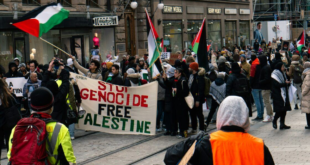MOGADISHU (Reuters) — The Somali government said on Thursday that Al Qaeda had made a young Islamist commander its leader in Mogadishu as fighting raged for a second day in the coastal capital.
Deputy Defence Minister Salad Ali Jelle told a news conference Aden Hashi Ayro — an Afghanistan-trained commander in his 30s who runs the Islamists’ feared Shabab, or military wing — was personally directing a growing insurgency.
“The government is being targeted by those who used to work with terrorists, the so-called Islamic Courts,” Jelle said. “And after they had a long consultation with Al Qaeda, they named Aden Hashi Ayro as head of [Al Qaeda] operations in Mogadishu.” The United States and the Somali government have long accused Ayro, and other Islamist leaders, of links to Al Qaeda.
But some critics say the government paints its political rivals as terrorists to secure more backing from Washington.
Thursday’s accusation came as insurgents again battled Somali government forces and their Ethiopian military allies, forcing hundreds of families to flee.
After heavy clashes on Wednesday that killed at least 16 and saw soldiers’ bodies dragged through the streets and burnt, fighting reignited in the city when Ethiopian tanks guarding a Somali government base opened fire on unidentified attackers.
Witnesses said the cannons thundered repeatedly over a 10-minute period, followed by the clatter of machineguns around the base, situated in a former defence department headquarters.
Â
Echoes of US mission
Â
A separate gunbattle also raged in the northern Ramadhan neighbourhood, witnesses said.
It was not immediately clear if there were any casualties.
But hundreds of residents — mainly women and children — fled the fighting with their belongings on donkey carts, minibuses and trucks, a Reuters reporter said.
“The fighting is still going on. It is the remnants of the Islamists and the government fighting,” said a Ramadhan resident who declined to be identified for fear of reprisal.
The defence department base has been a favourite target of gunmen who launch almost daily hit-and-run attacks on the government and its allies, including about 1,200 African Union (AU) peacekeepers from Uganda who arrived this month.
It and the Ramadhan neighbourhood were strongholds of the Islamist movement that ruled Mogadishu and its environs for the last half of 2006, until the government and Ethiopian soldiers defeated them and took the capital just before the new year.
Wednesday was one of the bloodiest days in Mogadishu since the government took the city from the Islamic Courts.
The grisly scenes recalled the aftermath of the 1993 downing of two US Black Hawk helicopters by Somali gunmen during a failed American operation to capture a warlord.
The images of dead American troops being dragged through the streets helped prompt the pullout of US, and later, UN peacekeepers who were battered by regular attacks in the Horn of Africa nation.
Though many believe the insurgents are defeated Islamists, analysts say criminals, warlord fighters and clan gunmen have also joined a loose coalition opposed to a government they believe is a tool of foreign interests.
 Eurasia Press & News
Eurasia Press & News

